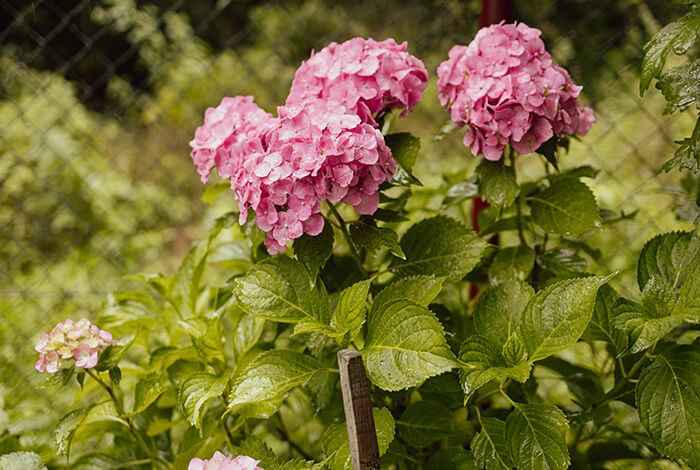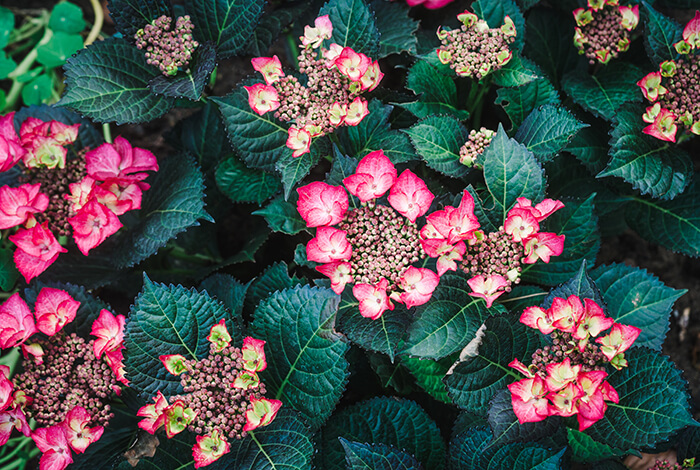![]() Reviewed By Joana Garrido DVM
Reviewed By Joana Garrido DVM
Are hydrangeas poisonous to dogs? Hydrangeas are some of the classic plants to grow in the back garden. They usually bloom around early spring and late fall in the U.S.
Although these plants brighten up lawns and create beautiful scenery, dogs should be kept away from them since they harbor poisonous chemicals.
Why Are Hydrangeas Poisonous to Dogs?

The hydrangea is also known as hortensia plant, hills of snow, or seven bark. All of its varieties are considered poisonous to dogs because of the toxins they produce called hydracyanosides.
These chemicals are a type of cyanogenic glycoside, which gets released if the plant is damaged. Thus, if your canine companion chews on a hydrangea, he will end up ingesting its poison.
Compared to other plant species, hydrangeas are considered mildly poisonous to dogs. Fido will have to consume them in large amounts for toxicosis to occur.
However, keep in mind that toy and small-breed dogs are more susceptible to poisoning because of their small bodies. It might take only a small quantity of the plant to induce poisoning.
For this reason, we still strongly advise you not to take risks and avoid growing hydrangeas in your back garden.
Do Dried Hydrangeas Pose the Same Danger?

Dried hydrangeas may retain small amounts of hydracyanosides. Hence, they are not as potent as fresh ones. Regardless, do not let your furry pal near them to avert the risk of poisoning.
Be warned that certain chemicals used in commercially dried hydrangeas are potentially harmful to dogs.
For instance, vegetable glycerine is considered nontoxic for pets, but if consumed in large amounts, it may trigger gastric upset.
What Are Other Adverse Reactions Hydrangeas Might Cause to Dogs?

There have been a few reports of humans experiencing contact dermatitis after coming into contact with a hydrangea plant. They suffered from skin irritation and rashes.
No sufficient information is available about the occurrence of these clinical signs in dogs. Although it remains to be seen if the plant can induce this skin problem in animals, it would be better to be cautious.
Make sure that your dog does not come into contact with a hydrangea, especially if he is a thin-furred or hairless breed.
Dogs with thick coats are less likely to experience contact dermatitis because their dense fur protects their skin from the plant’s offending chemicals.
Which Parts of Hydrangeas Are Poisonous to Dogs?

Hydracyanosides are found in the bark, flowers, leaves, and stems of the hydrangea plant. High concentrations of the toxin are commonly observed in its flowers and leaves.
For this reason, we discourage you from walking your dog in areas with hydrangeas during the plant’s blooming season.
What Are the Common Symptoms of Hydrangea Poisoning in Dogs?
GI symptoms are the first to occur in a dog experiencing cyanide poisoning after ingesting hydrangeas. These include abdominal pain, inappetence, vomiting, and diarrhea.
Other clinical signs to look out for are:
- Body tremors
- Excessive drooling
- Fast heart rate
- Hyperventilation
- Seizures
In general, dogs begin to show these symptoms within 15 to 20 minutes if they have consumed the plant in large quantities.
What to Do If I Suspect That My Dog Has Ingested Hydrangeas?

Collect relevant pieces of information that you can find about the accident. Ask yourself:
- Around what time could my dog have eaten the plant?
- How much of the plant has he consumed?
- Which parts of the plant were ingested?
- Is he showing any signs of hydrangea poisoning?
Afterward, contact a veterinarian or a pet poison helpline. They will help you determine if you need to take your canine friend to the animal clinic or keep him at home for a house treatment.
If they suggest the latter, bring a sample of the hydrangea plant with you. It can help the vet confirm if your pooch might experience cyanide poisoning or not.
How Is Hydrangea Poisoning in Dogs Treated?

A veterinarian will induce vomiting if only a short time has passed when your dog ingested the plant. This method prevents remaining hydracyanosides from getting absorbed into his system.
The next rounds of treatment will depend on the symptoms present in your pet. For instance, if he keeps on vomiting and having diarrhea, medications like anti-nausea will be prescribed to counteract them.
IV fluid therapy will also be administered to prevent excessive dehydration. It also aids in flushing out toxins from his system.
As for cardiovascular symptoms, your pooch’s heart will be monitored using an ECG to check for instability, and he will also receive medication.
Once Fido has recovered and is fit to go home, you might be required to keep him on a bland diet for a few days. It allows his stomach to rest and recuperate.
FAQs About Why Are Hydrangeas Poisonous to Dogs
1. What Happens If My Dog Eats a Hydrangea?
If your dog eats copious amounts of hydrangea, GI and cardiovascular symptoms may appear such as vomiting, diarrhea, and fast heart rate.
Get him checked by the vet so he receives appropriate treatment. If possible, take a sample of the plant with you as it significantly helps in acquiring the right diagnosis.
2. How Toxic Is Hydrangea to Dogs?
Hydrangea is mildly toxic to dogs. Ingesting a small quantity of this plant is unlikely to trigger clinical signs. However, if your dog is a small breed, monitor him more closely since he is vulnerable to the toxins because of his size.
3. Can Dogs Smell Hydrangeas?
Since dogs have a sharper sense of smell than humans, they can smell hydrangeas much better than we do. Some might even be enticed to take a bite out of the plant because of their curiosity.
For this reason, keeping a hydrangea plant in your home or back garden is not recommended. If removing the plant is not feasible, make sure that your furry pal does not gain access to it.
Put it on top of a stable high shelf or use a hanging planter when placing it at home. If you are planting it in the back garden, surround it with a tall and durable fence to keep your canine friend out.
4. Is Hydrangea Root Safe for Dogs?
There is a lack of information if hydrangea root is safe for dogs. We suggest erring on the side of caution and do not let your furry pal ingest it.
Roots are highly fibrous and difficult to digest. Thus, take note that the risk of stomach obstruction is also possible.
Conclusion
Are hydrangeas poisonous to dogs? Yes, hydrangeas are poisonous to dogs because they contain hydracyanosides. These toxins are present in high concentrations on the leaves and flowers of the plant.
Hydrangea toxicity in dogs is often mild, but it still requires medical support. If your pet suffers from this condition, seek help from the vet or a pet poison helpline.

